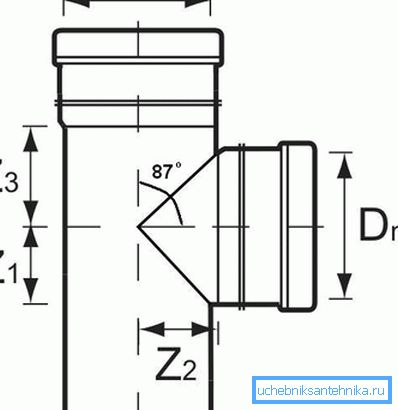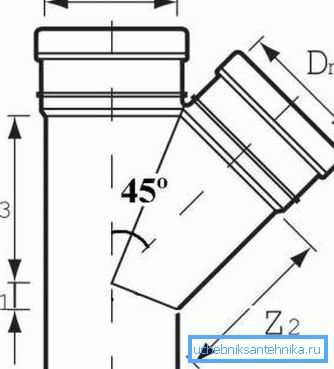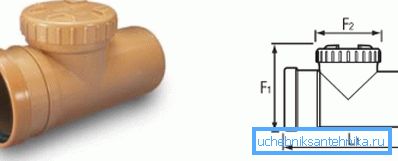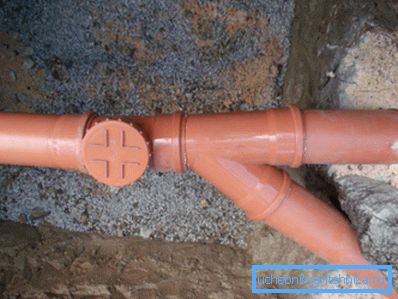Sewer tee: main types and methods of use
It is no secret that the wastewater discharge system consists not only of pipes, but also of fittings, such as tees for sewer pipes, for example. A wide range of different fittings has its own purpose and, if necessary, is used to dilute the main pipeline to several directions, to change the direction of the pipe, etc.
However, in this article we will consider in detail what the sewer plastic tees are, and how they are used in the construction of household wastewater disposal systems.

Simplicity of assembly thanks to use of special connecting elements
Sewers built with the use of PVC pipes and connecting elements, are characterized by several advantages, including:
- affordable price;
- low weight;
- absolute corrosion resistance;
- long service life without the need for regular cleaning;
- ease of installation work.
Speaking about the modern plastic waste disposal system, I would like to especially note such quality as ease of installation. Installation is really simple and it becomes possible through the use of special connecting elements - fittings.
Main varieties
In the construction of domestic sewage systems, three main types of connecting tees are used, which are different in configuration and are intended to perform certain specific functions.

- 87 ° or 90 ° sewer tees - The main purpose of this part is to connect the vertical riser to the horizontal sections of the pipeline.

- 45 ° sewer tees - These connecting elements are used for fastening plastic pipes in the construction of most horizontal branches.

- The revisions are a sleeve with a perpendicular outlet located, which is closed by a removable lid.. As the system is operated, the cover can be removed in order to inspect the degree of clogging or in order to clean the clog.
The listed varieties are quite enough to form a complete household waste disposal system. But in order to count on success in installation, it is necessary to take into account the sizes of these connecting elements and their conformity to the standard sizes of pipes.
Tees, in accordance with the diameter of the pipe connection, can have the following cross-sectional sizes: 110 mm, 160 mm, 200 mm, 250 mm and 315 mm. For the needs of the construction of industrial systems with greater capacity, connecting elements with a cross section diameter of 400 mm and 500 mm are manufactured.
In addition, the dimensions of the sewer tee 110 mm and other modifications may not be the same in all directions. For example, the cross sections of pipes of the horizontal direction may be the same, whereas the vertical or diagonal outlet may have a smaller or larger diameter.
Construction features
Regardless of size and configuration, the design of the polymer tee is simple. The output of the product is made in the form of a conventional pipe with seamed edges. Two input parts, for example 50 by 50 mm, are equipped with special sockets, which include the ends of pipes of suitable diameter.
For maximum density, tightness and reliability of the connection, the sockets have special rubber rings-seals. According to the manufacturers of polyvinyl chloride pipes and related accessories, a properly assembled joint serves at least 20 years without the need to replace the seal.
Installation Rules

Instructions for installation work with the use of plastic T-joints are characterized by ease of implementation and may well be done by hand.
Pipeline installation will be completed successfully if you adhere to the following recommendations:
- When constructing horizontal wiring, we exclusively use tees with a 45-degree tap.
Important: If you use tees with a perpendicular connection when building horizontal wiring, the probability of frequent blockages of the sewage system during subsequent operation increases significantly.
- Sockets fitted with a socket should be directed to the initial higher point of the network. Thus, the socket should function as an entrance to the connecting element, while the pipe end should be an outlet.
- Rubber seals cannot be trimmed or removed altogether. The seal is specially inserted in order to make the connection as tight and tight as possible, so you should not be surprised that during installation you have to put some effort.
Tip: In order to simplify the task, it is enough to lubricate the inner surface of the connected elements with soap and water before installation. In this case, the pipe will be much easier to enter the socket, and the required density of the connection will be achieved.
- The joints of the wiring elements with a diameter of more than 50x32 mm are advisable, and in some cases necessary, to be fixed to the adjacent surface with clamps of the holder-brackets.
- Installation of audits should be carried out on pipeline sections with free access. As a rule, inside a private house such elements are not applied at all or are set in limited quantities.
Modifications from other materials

Currently, in addition to the widely used polymer systems, metal, ceramic and even asbestos-cement sewers are produced.
Of course, when connecting pipes made of such materials, the appropriate connecting elements are used. For example, for pipes made of cast iron, a cast iron tee is used, produced in accordance with the requirements of GOST 6942.14-69.
Connecting elements of this type can be made to connect the threaded, bell-shaped and socketless type. Ceramic asbestos-cement and concrete analogues are made only with regard to the socket connection.
Conclusion
Now you know what is a plastic sanitary tee with dimensions 110 to 110 by 110 mm or its cast-iron analogue with dimensions 100x100x50 mm. In addition, we figured out how to install the most popular connecting elements made of polyvinyl chloride.
More useful information can be obtained by watching the video in this article.